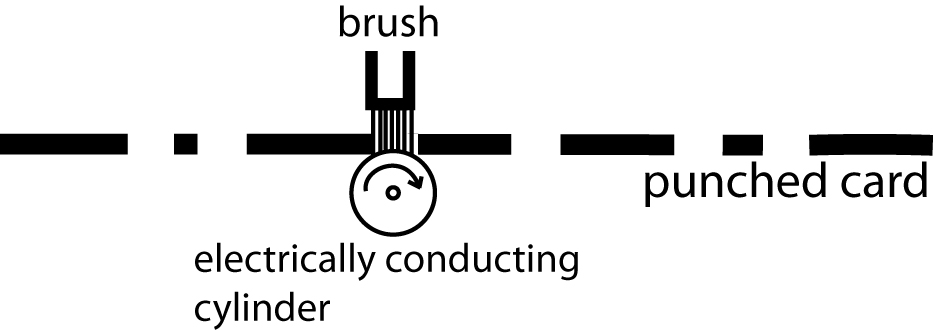Reading a punched card is done by either mechanical, optical or electrical scanning of the inserted punch card. Therefore a pile of cards is put into the hopper and ballasted. After the pile is being loosened by a fan, the cards are read one after the other.

Mechanical Card Reader:
A mechanical probe is scanning the inserted punch card and tests wether or not a hole exists.
Electrical Card Reader:
The electrical card reader posesses some wiring pins, which lead to an electrical contact on every hole. This short current flow is interpreted as a one by the machine. Through this principle electrical readers are a lot faster than mechanical ones.
Optical Card Readers:
Optical card readers do not have any pins or probes to scan a punch card, but they do have a set of light barriers, which test for holes. If the light shines through a hole it hits a light-sensitive device, which transforms the lightenergy into electrical currency, that is amplified and evaluated.
Machines: eg. Honeywell model 1200, 2200 and 4200, IBM Series 1400 or Series 360, Univac Series 9000, Siemens 2000 and 4000 — Telefunken, Zuse etc.
The card puncher punches the code into the cards. Therefor it is fitted with a hopper, from which a card is pulled at a time. This card can be printed on using a keyboard. To punch the holes a stamp is moving from left to right and punches holes from an orthogonal angle. Usually card punchers can only punch 10 holes per second. While errors may occour everytime there is a copy-key that copies the card to a certain column and then one can manually punch in the other holes. The incorrect card has to be removed manually. More sophisticated machines can additionaly print the content to the card as clear text. Some people however can even read punch cards without the clean code printed upon them.
An advancement of the mechanical and electromechanical punchers are programable punch card punchers, that could manipulate cards without having to completely reprint them. Those kind of punchers have still been in use in computing centres till the late 1980's
Machine: IBM 66, first electromechanical puncher 1923 by IBM (IBM 011)
⇑